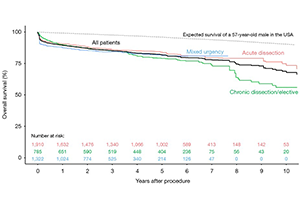Long-term outcomes of the frozen elephant trunk procedure: a systematic review
Abstract
Background: The frozen elephant trunks (FET) procedure remains an increasingly popular approach to address complex multi-segmental aortic pathologies, owing to their ability to promote false lumen thrombosis and reduce the need for second-stage operations. While the short-term outcomes of such procedures have been shown to be acceptable, much less is known regarding long-term outcomes. This systematic review evaluates long-term outcomes of the FET procedure.
Methods: Studies with at least 12 months follow-up data on FETs were identified in four electronic databases. All studies were reviewed by two independent researchers and relevant data extracted. Long-term outcomes, including overall survival, freedom from reintervention, and freedom from aortic events, were evaluated using patient data recreated from digitized Kaplan-Meier curves.
Results: Thirty-seven studies with 4,178 patients were identified. Majority of the studies focused solely on acute dissections. Average follow-up was 3.2 years. Overall survival at 1-, 3-, and 5-years were 89.6%, 85.2%, and 82.0%, respectively. Freedom from reintervention at the same timepoints were 93.9%, 89.3%, and 86.8%, respectively. Mortality, permanent neurological deficit and spinal cord injury were 10.2%, 7.7%, and 6.5%, respective.
Conclusions: Survival after the FET procedure is favorable, though ongoing close serial monitoring is essential to assess for the need for further reintervention. Larger multi-institutional registries are required to provide more robust evidence to better elucidate the patient cohort that would most benefit from the FET.
Cover






